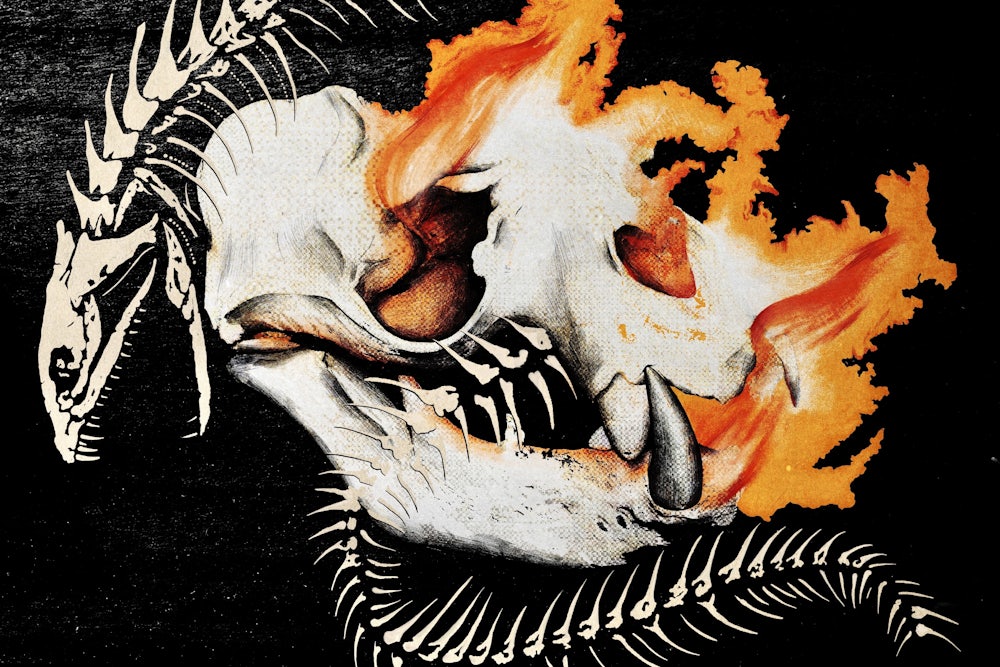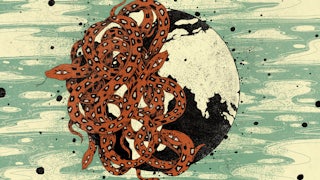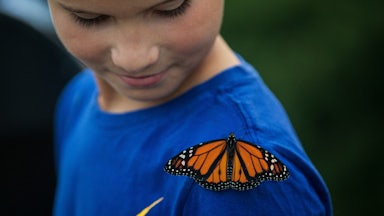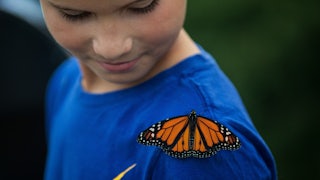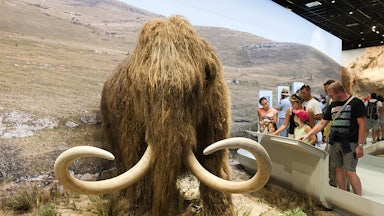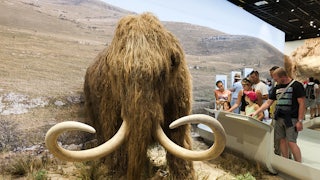A sea lion slumps on its back, belly and neck exposed. A wildlife worker swabs another’s nose; curled into a comma, the emaciated animal screeches in protest. In another shot of Reuters B-roll, humans in hazmat suits shovel a shoreline grave under colorless skies, sprinkling a red mass of carcasses with chemical powder before sealing the burial with dark wet sand.
The numbers are as bleak as the footage: More than 3,400 sea lions sickened and dead of the H5N1 variant of avian influenza in Peru this winter and spring. With the animal weighing, on average, about 770 pounds, each of those infected corpses threatens to further pulse the pathogen along the Peruvian coastline, according to researchers there.
Scenes this stark are harder to ignore than slower forms of species demise quietly spread out over time and space: Here is a riverbank littered with lifeless mussel shells, the plains where 200,000 antelope dropped dead, corals stripped of sea urchins, a continent across which bush fires killed or displaced three billion animals. Die-offs like these jolt us even as tens of thousands of species steadily twinkle off into extinction in the Anthropocene. “They really feel biblical in their proportions,” Sam Fey, an associate professor of biology at Reed College, told me.
Their scale—that of carnage—seems to speak to our modern ecological anxiety, rage, and grief; mass mortality events are material evidence of anthropogenic apocalypse, an unignorable and immediate tally of the ravages we’ve sown. And they will likely become more common as heat waves, droughts, disease outbreaks, storms, fires, and other environmental disturbances grow more frequent and deadlier. News coverage of die-offs, however, fails to acknowledge all we don’t understand about mass death. In reality, we’re nowhere close to grasping the repercussions these cascades of death have on ecosystems. “We’re still a far way away from having a firm view,” Fey said. “As a field we know very little about these events.”
Each year, millions of salmon spawn, stop eating, rot alive, and dissolve away. When billions of cicadas emerge from the ground, their remains fertilize that same soil a few weeks later. A masting beech tree can carpet a square meter with 500 seeds, almost none of which will get the chance to sprout and take life. Nature is full of episodes of mass death; not all are devastating mass mortality events.
The kind of mass mortality events worrying scientists are anomalous punctuations—they are not an evolved and recurring dynamic in a creature’s life history (as the examples above are). They also, for the most part, don’t discriminate. “It’s everything: top of the food chain all the way down,” University of Arkansas biologist Simon Tye told me. “It’s just a full-on decimation of the population.” Most characteristically, these occurrences are dramatic. Experts have described them as single events that wipe out huge chunks of a population, kill more than a billion individuals, or leave behind 700 million tons of dead tissue (a mass equivalent to one million Christ the Redeemer statues).
In the last decade or so, mass mortality events worldwide have included the loss of 450-plus elephants in Botswana, 18,000-plus migratory birds in India’s Sambhar Lake, 350 Magellanic penguins in Argentina, hundreds of emaciated gray whales along the Pacific coast, and 99.9 percent of Spain’s fan mussels. Five thousand dead red-wing blackbirds rained down in Arkansas, and 45,000 flying foxes hung from trees and piled on the ground in Australia. Lightning struck down a huddle of 300 Norwegian reindeer. Billions of starfish melted into goop.
In 2022 alone, many die-offs made themselves known by washing ashore: 2,500 endangered seals on the Caspian Sea’s Russian shores, hundreds of seabirds on ice and shoreline in Newfoundland, more than 2,250 trout and salmon along Ireland’s Glenagannon River, thousands of crabs and lobsters along England’s River Tees, 60 dolphins on Bulgaria’s Black Sea coast.
For some, the culprit was clear. Microscopic algae smothered aquatic life to death in the San Francisco Bay. Drought killed 512 wildebeests, 430 zebras, 205 elephants, 51 buffaloes, and 12 giraffes in Kenya. Starvation wasted away the hundreds of flightless little blue penguins that washed up on New Zealand beaches at half their typical weight.
Compressed and compiled, these death tolls collapse into senselessness; it’s a familiar feeling to the modern writer or reader. “While statistical shock and awe is abundant, we are often unable to grasp the true meaning of such figures—stymied by basic innumeracy, the incomprehensible scale of our present crises, and the profound mismatch between hard data and human feeling,” Eleanor Cummins wrote of Covid-19 for this magazine in 2020. But a careful look at any mass mortality event can restore its contours. Take the hundreds of Cape fur seal carcasses that washed up on Namibia’s coastline early last year. On a single February day, more than 400 appeared along the water’s edge. In one photograph taken by biologists during the aftermath, a dark, wet seal pup lies as flat as a slipper near a tape measure indicating it never grew to be longer than 75 centimeters long; in another, 14 dead seals are spread on the beach in a lonely colony of dark, lifeless curves. “It’s been mentally and emotionally taxing,” a conservationist said at the time. “It truly feels like a war zone out there.”
Unfortunately, experts say it’s fair to categorize mass mortality events as a phenomenon on the historic upswing. “They’re happening more often, and more individuals are dying each time they happen,” Tye said. In 2015, Fey and his colleagues reviewed more than 7,000 mass mortality events since 1940 and found that reported die-offs have, indeed, become more common for birds, fish, and marine invertebrates. The scientists attributed one in four mass mortality events to disease (like the avian flu), one in five to human perturbation (like contamination), and about one in six to biotoxicity (like harmful algae blooms). One in four, they found, was directly influenced by climate: weather, heat stress, oxygen stress, starvation. Other research on North American freshwater lakes and the Mediterranean Sea demonstrates a link between rising environmental temperatures, extreme heat events, and die-offs.
Often during mass mortality events, a tangle of stressors will ensnare a vulnerable species in crisis, experts say. Warming waters, for example, combined with nitrogen pulses from wastewater pollution or stormwater runoff can fuel harmful algal blooms, which asphyxiate and suffocate life. Heat waves and droughts set the stage together for wildfires, which can then leave a landscape vulnerable to flooding. Warmer conditions can abet pathogenic spread or upset delicate microorganism-host relationships.
It’s this cascading effect that has some scientists worried. “One catastrophe makes it more likely that you’ll suffer a second or third,” said Christopher Harley, a University of British Columbia zoologist. And every devastation leaves an ecosystem more vulnerable for the next. “It might take years to get back up from that loss.”
Welcome to the necrobiome, the ecosystem of carcasses. In the necrobiome, dead matter is not inert—it is a base unit of life: Carrion beetles pilfer, maggots feast, seeds scatter, raccoons scavenge, vultures peck, and microbes bloom. “If you zoom in to the microbial level, life is exploding. It’s multiplying, it’s diversifying,” Jeffery Tomberlin, a professor in entomology at Texas A&M, told me. “It’s a beautiful thing.”
But our understanding of decomposition largely comes from single-carcass studies. Those fundamental dynamics, experts warn, might collapse under the sudden appearance of a thousand times more carrion than an ecosystem is designed to recycle—as in the case of a mass mortality event. That could lead to carcasses mummifying instead of breaking down, pathogens seeping into an ecosystem’s soil and water, and oxygen-starved dead zones. Hypothetically, not certainly. When it comes to mass mortality events, Harley said, “there’s a lot of blank areas on our ecological map.”
With good reason: Die-offs can be surprisingly cryptic in nature and exquisitely onerous to analyze in practice.
Because mass mortality events are inherently unpredictable in time and space, we often lack a given site’s baseline demography from before it’s wiped out. (You can’t, after all, monitor an area anticipating catastrophe.) So we struggle to accurately capture the exact extent of devastation. An event’s suddenness also challenges researchers to assemble as quickly as possible to gather postmortem data. “It’s hard to be in the right place at the right time with the right equipment,” Tye said. What’s more, some die-offs are impossible to detect at all. In oceans, dead organisms sink to depths beyond observation; in the tropics, they more speedily decompose out of sight.
Elsewhere, scientists might try to understand a phenomenon by replicating it and observing it in a controlled setting. “At no point are you ever going to do that” for mass die-offs of wild animals, Tomberlin said. “It’s just not on the table.” Slaughtering and studying domesticated livestock—arguably, a more practical approach—would fail to shed an accurate light on natural decomposition processes, given the industrial antibiotic regimens that fundamentally alter the animals’ microbiomes, and therefore their necrobiomes.
Some researchers have found workarounds. In 2016, for example, a team of wildlife biologists at Mississippi State University acquired 6,000 pounds of invasive feral swine carcasses from the Department of Agriculture and other state and federal agencies with removal programs. They left the carrion in forest plots to rot and observed the dramatic metamorphosis that ensued. A writhing, six-inch-deep, 30-foot-long stream of blowfly maggots flooded the carcasses, carrying away scientific equipment and heralding the arrival of thousands of flies, beetles, spiders, hornets, armadillos, lizards, and vultures. To collect microbial data during decomposition, researchers waded through a “muck and soup and slime” of corpse wax. The soil’s new chemistry—weighted with excesses of nitrogen, gases, and acidic body fluids—killed off grasses and trees, opening up the forest canopy and shedding more sunlight on its floor.
In 2019, the MSU team dumped nearly 15 tons—30,000 pounds, or about 200 bodies—of donated feral hog carcasses in Oklahoma prairie grasslands. They discovered that grasses in sites where they left a single hog seemed to bounce back, fueled by the carcass’s recycled nutrients. But in plots where scientists discarded 10 or more cadavers at once, the effect was poisonous: Flora stayed brown and dead for months. The soil microbiome lost key fungal and bacterial species; in some patches, surrounding trees died off.
“If you push a system, it ultimately will collapse or kick back,” said Richard Kock, a retired professor of wildlife health and emerging disease at the Royal Veterinary College in London. But which one will happen is impossible to predict.
The summer of 2021 was a morbid one across North America’s western coast, as temperatures rose above 100 degrees (and up to a record-breaking 121 degrees in British Columbia). More than a thousand people died. Crops roasted and withered. Wildfires raged, and glaciers melted. In Seattle, juvenile terns tried to flee rooftop nests for cooler cover and died, plunging to the burning asphalt pavement below. Along the shoreline, billions of marine invertebrates—barnacles, mussels, oysters, clams, gastropods, crabs, sea stars—cooked alive. On a single, 100-meter stretch of shoreline, the heat struck one million bay mussels dead; on another, it killed 10 million barnacles. “It was so insufferably hot that things couldn’t handle it,” Harley said. “Anyone who lived near the coast knew something was going wrong because the breeze off the shore was awful.”
For more than a month, Harley and his colleagues functioned as coroners, documenting and assessing the heat dome’s aquatic victims, many of which remained for weeks physically attached to the shore where they had (until their deaths) provided housing for crabs, sea cucumbers, and worms. It was supremely bleak work, he said.
But today, photographs document what happened to the landscape after the grizzly die-off receded: Tens of thousands of new mussels and barnacles have sprung up in the void. “They’re back already,” Harley said. And by carefully studying the mass mortality event’s scale and scope, scientists hope to bolster the shoreline’s survivability. They’ve concluded that marine protected environments should prioritize north-facing and complex rock faces as well as organisms like mussels and seaweeds, all of which could provide protective shade for sensitive species in future heat waves.
Kazakhstan’s saiga offer another tale of resilience in the face of massive mortality. During an uncommonly hot and humid May, more than 200,000 of the critically endangered antelope—about 60 percent of the world’s population—dropped dead all at once. The soupy weather conditions had turned a microbe in the animal’s snout, the normally co-habitating bacterium Pasteurella multocida, virulent and deadly. But in studying the saiga fatalities, researchers discovered some remaining healthy herds outside the killing’s envelope; they’ve surpassed a population of one million in the eight years since the die-off. “That small population has reestablished itself,” said Kock, who studied the mass mortality event and its fallout. “There is resilience.”
And yet any resilience, in the context of mass death, feels like a paltry consolation prize. “Everything’s just kind of hitting the fan at once,” Tye told me. “I’m honestly just kind of ashamed that we’ve gotten to this point.”
About 70 percent of Americans are worried about climate change, according to a 2021 Yale and George Mason University survey. Photos and stories of die-offs confirm that that anxiety is well founded—and tempt news writers with a tangible, legible manifestation of the biological loss looming all around us.
We see the same dynamic with the loss of human life; sudden catastrophes like wildfires and earthquakes get far more coverage than equally deadly threats that are harder to capture in a single image or headline, like the seven million lives lost each year to air pollution. How, for example, would we effectively convey that the banalities of modernity—motor vehicles, industrial output, urban smog, and indoor smoke—have forced 99 percent of the global population to breathe in air that dangerously exceeds international guidelines for pollutants? The threat is too abstract for imagination alone to grasp.
When it comes to biodiversity, animal mass mortality events offer us the regalement of war stories in our narrative stalemate with climate change. That’s useful, perhaps—but we lose nuance as a result. Stories about die-offs, as Tye pointed out, usually hyperfocus on the gore of specific events. “I wish more [mass mortality event] articles talked about how everything is crumbling,” he told me.
News coverage of die-offs often focuses entirely on what’s disappeared, and how dramatically. But mass mortality can be as much about germination as about demise. These events ask us to consider the difference, if any, between what is overwhelming to an ecosystem and what is overwhelming to us. And they force us to confront how little we know about the world in crisis around us. Without understanding how life goes on with so much death around, we can’t begin to fathom what tomorrow’s climate-changed world may look like—to the planet’s and our own peril.
